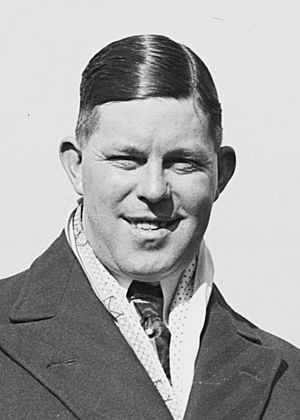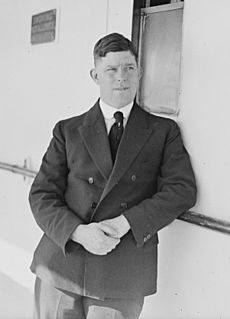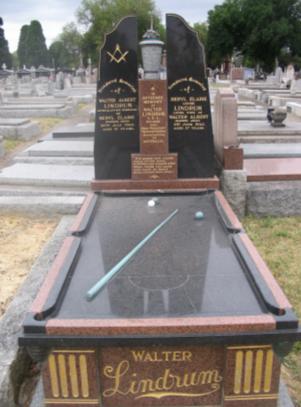Walter Lindrum facts for kids

Lindrum, c. 1930
|
|
| Born | 29 August 1898 Kalgoorlie, Western Australia |
|---|---|
| Died | 30 July 1960 (aged 61) Surfers Paradise, Queensland, Australia |
| Sport country | |
| Professional | 1911–1950 |
| Tournament wins | |
| World Champion | World Billiards Championship (1933, 1934; retired uncontested in 1950) |
Walter Albert Lindrum, also known as Wally Lindrum, was an amazing Australian billiards player. He was born on August 29, 1898, and passed away on July 30, 1960. Walter was a professional player of English billiards, a game similar to pool.
He held the title of World Professional Billiards Championship from 1933 until he retired in 1950. Walter was the first Lindrum born in Western Australia. He was named Walter Albert to match the initials of his home state. He is known as one of the best billiards players ever, holding 57 world records. Some of these records are still unbroken today!
Contents
Walter Lindrum's Early Life and Family
Walter Lindrum came from a family of talented billiards players. His grandfather, Frederick William Lindrum I, was Australia's first World Professional Billiards Champion in 1869. Walter's father, Frederick William Lindrum II, became an Australian Billiards Champion at just 20 years old.
Walter's father believed he was the best player in the world between 1909 and 1912. He chose to coach his sons, Walter and his older brother Frederick William Lindrum III, instead of playing in public matches. Frederick III also became the professional Australian Billiards Champion in 1909. This family is often called the greatest billiards family in history.
Walter was born in Kalgoorlie, a mining town in Western Australia, on August 29, 1898. When he was three years old, he had an accident and lost the tip of his right index finger. Because of this, his father taught him to play billiards using his left hand.
Walter spent much of his childhood practicing billiards. He would practice up to twelve hours a day! His father taught him on their two billiard tables at the Palace Hotel in Kalgoorlie. He also learned from William (Billy) Weston, a former New Zealand Billiard Champion. Weston taught him "top of the table" play, a special technique to make longer breaks.
Walter's family moved around a lot. He played his first professional game when he was only 13 years old. By the age of 16, Walter was regularly making breaks of over 1,000 points during practice. This happened at the London Tavern in Melbourne, where his father ran a billiard parlor. By 1921, Walter was beating his older brother, Frederick III, who was then the Australian Champion. Walter, however, refused to play his brother for the title.
Walter Lindrum's Personal Life
Walter Lindrum was married three times. His first marriage was to Rose Coates in 1929 in Sydney. Sadly, she passed away soon after. His second marriage was to Alicia Hoskin in London on April 9, 1933. She was known as Sue, and they traveled the world together for many years. They divorced in 1955. Walter married for the third time in July 1956, to Beryl Elaine Carr, who survived him.
Walter Lindrum: A Billiards Champion
In the mid-1920s, Walter Lindrum was so good that many players in Australia refused to play against him. He often played exhibition matches instead, especially against the New Zealand Billiard Champion, Clark McConachy.
In 1930, Lindrum published his first book, Billiards. He later updated it in 1940 as Billiards and Snooker. The money from this book went to his "Lindrum War Drive," which was his effort to raise funds during World War II.
In 1929, Willie Smith, a World Champion from England, visited Australia. He played three close matches against Lindrum. In the third game, Lindrum had to stop playing because his wife passed away. Even though it was technically a forfeit, Smith refused to take the trophy and insisted Lindrum receive it.
On December 7, 1929, Lindrum set a world record break of 3,262 points. The cue he used for this record has an engraved plate that says, "The World's Record Break Cue. 3262 Dec.7th 1929. Walter Lindrum, Australia." This cue is now kept at the Commonwealth Club in Canberra.
Between 1929 and 1933, Lindrum was the top player in English billiards. Games were usually played to 24,000 points. Lindrum was so skilled that he would often give his opponents a head start of up to 7,000 points! Lindrum and his main rivals – McConachy, Smith, Joe Davis, and Tom Newman – were known as "the big five" in the press.
In 1930, when Lindrum was on his second tour of England, the famous cricketer Donald Bradman and other members of the Australian cricket team sometimes watched Lindrum play. Bradman was even called "the Lindrum of cricket" by a critic, showing how highly Lindrum was thought of.
On February 19, 1931, Lindrum gave a special billiards show for King George V and the Royal Family at Buckingham Palace. The King gave Lindrum a pair of gold cufflinks with the royal symbol. Lindrum wore these cufflinks for the rest of his life.
Lindrum made his record break of 4,137 points in a match against Joe Davis on January 19, 1932. This amazing break led to a change in the rules of the game. Because Lindrum scored so many points with close cannons (902 cannons in total), a new rule was made. The cue ball now had to cross the baulk line every 200 points during a break.
Lindrum won the World Professional Billiards Championship in 1933 and 1934. He held this title until he retired in 1950. After winning in 1933, Lindrum wanted to defend his title in Australia. The 1934 match was held in Melbourne during its centenary celebrations. His challengers were Clark McConachy from New Zealand and Joe Davis from the United Kingdom. Lindrum won, with Davis as the runner-up.
After this, no one challenged Lindrum for the title, so it remained with him until he retired. The title then went to McConachy in 1951. Some people said Lindrum's playing style was too mechanical. However, rival and six-time World Champion Tom Newman said, "He is showing you everything the beautiful game can show."
During World War II, Lindrum played about 4,000 exhibition games. He raised over £500,000 for the war effort, including money from his book sales. Throughout his life, he raised more than £2 million for charity. He was recognized for his efforts and made an Officer of the Order of the British Empire (OBE) in 1958.
Walter Lindrum's Amazing Records
Walter Lindrum set many world records during his career:
- In June 1927, in Melbourne, he set a world speed record. He scored 816 points in just 23 minutes during a break that wasn't even finished.
- In 1930, in Manchester, Lindrum set a record total score of 30,817 points in a two-week match against Willie Smith. In this match, he made 10 breaks over 1,000 points, with his highest being 2,419.
- In his final match of that tour against Smith in London, Lindrum set many more records. These included the highest individual total score (36,256), the biggest winning difference (21,285), a record average score per turn (262), and a record number of breaks over 1,000 points (11).
- His world record break of 4,137 points happened on January 19, 1932, against Joe Davis in London. Lindrum played for 2 hours and 55 minutes, making about 1,900 scoring shots in a row.
- He also holds the record for the fastest century break (100 points) in 46 seconds.
- He scored 1,011 points in 30 minutes.
- In 1933, during a tour in South Africa, Lindrum set a new world record for fast scoring. He completed 1,000 points in 28 minutes in Johannesburg.
Walter Lindrum's Legacy and Recognition
Walter Lindrum passed away suddenly on July 30, 1960, at the age of 61, while on holiday in Surfers Paradise, Queensland. His death was officially due to heart failure.
After his death, the famous cricketer Sir Donald Bradman wrote that Lindrum was "not only the greatest billiards player who ever lived, but he was also the most modest of great champions."
Lindrum's body was returned to Melbourne, where he received a state funeral attended by 1,500 people. He was buried at Melbourne General Cemetery. Champion cyclist Sir Hubert Opperman helped raise money for Lindrum's unique grave monument, which looks like a billiards table with balls and a cue. Even today, his grave is one of the most visited in that large cemetery.
In 1981, Lindrum was honored on a postage stamp issued by Australia Post. He was inducted into the Sport Australia Hall of Fame and the Western Australia Sporting Hall of Champions in 1985. His house in Albert Park, Melbourne, is recognized for its historical connection to him. Lindrum is seen as one of Australia's greatest sporting heroes, alongside other legends like Donald Bradman.
In Melbourne, the Hotel Lindrum on Flinders Street has many items that belonged to Walter Lindrum. The building used to be Lindrum's Billiard Centre, run by Walter's niece, Dolly. One of the original billiard tables from the center has been fully restored there.
The mathematician John Littlewood once called one of Lindrum's shots "the best stroke ever made in a game of billiards." Lindrum purposely made a shot where the white balls ended up touching, which allowed him to continue his break.
In 2010, there were efforts to get a large collection of Lindrum's belongings displayed at Australia's National Sports Museum. This collection includes his personal items, newspaper clippings, diagrams of his shots, letters, and photographs.







